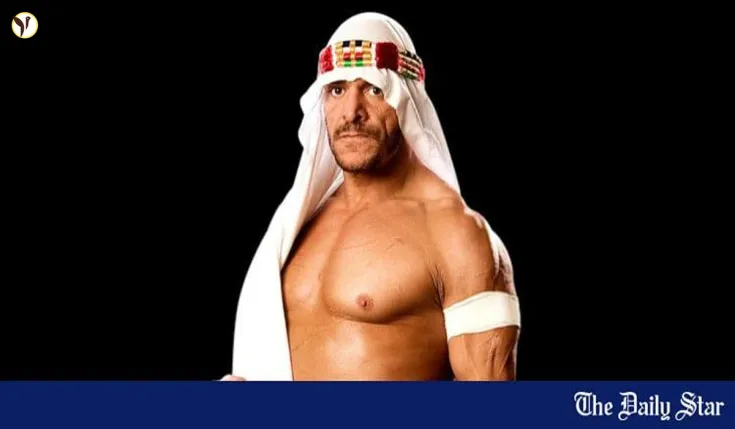The Arabian Nightmare Has Fallen: Remembering the Legacy of Sabu
The wrestling world mourns the loss of a true innovator, a hardcore legend, and a man who defied gravity and expectations inside the squared circle: Sabu. The "Suicidal, Homicidal, Genocidal, Death–Defying Maniac," as he was famously known, passed away recently at the age of 60, leaving behind a legacy of broken tables, shattered chairs, and unforgettable moments. From his early training under the legendary Sheik to his death-defying aerial assaults, Sabu carved a unique path in professional wrestling, influencing generations of performers and forever etching his name in the annals of hardcore history.
Born Terry Brunk, Sabu was immersed in the world of professional wrestling from a young age. His uncle, the legendary Original Sheik (Ed Farhat), took him under his wing, providing rigorous training in the Sheik's signature hardcore style. This brutal, anything-goes approach would become the cornerstone of Sabu's own in-ring persona and a major influence on generations of wrestlers. His ring name, a shortened version of "Sabu the Elephant Boy," was inspired by the titular character of the 1937 adventure film.
Making his professional wrestling debut in 1985 in his uncle's promotional territory, Big Time Wrestling, Sabu quickly gained notoriety for his daredevil maneuvers and willingness to push the boundaries of traditional wrestling. This early success foreshadowed his iconic hardcore career.
Innovative Wrestling Style and Hardcore Legacy
Sabu's in-ring style was a unique blend of high-flying maneuvers and hardcore brutality. Signature moves like the Air Sabu (a triple jump moonsault, often through a table), the Arabian Facebuster (a slingshot leg drop bulldog), and the Arabian Skullcrusher (a springboard cutter) showcased his innovative approach to offense. The frequent incorporation of a steel chair into his attacks added another layer of danger and excitement to his arsenal. This fearless approach, combined with his willingness to endure extreme punishment, solidified his place as a pioneer of hardcore wrestling.
His influence on the hardcore genre is undeniable. He helped popularize the use of tables, barbed wire, and other foreign objects in matches, pushing the boundaries of what was considered acceptable in professional wrestling. His dedication to the extreme, evidenced by his participation in numerous no-rope barbed wire death matches, inspired a generation of hardcore wrestlers and shaped the landscape of the genre.
Career Highlights and Major Promotions
Sabu's career ignited in Extreme Championship Wrestling (ECW), where his daredevil, hardcore style captivated audiences. His brutal rivalries with the likes of Taz and Rob Van Dam, filled with high-risk maneuvers and chaotic matches, became synonymous with ECW's anti-establishment identity and helped propel the promotion to prominence. He also wrestled for Frontier Martial-Arts Wrestling (FMW) in Japan, further solidifying his hardcore reputation in deathmatches and showcasing his innovative, high-flying offense. While his impact was less pronounced in World Championship Wrestling (WCW) and Total Nonstop Action Wrestling (TNA), he made appearances in both organizations.
One of Sabu's most memorable mainstream moments came during his time in World Wrestling Entertainment (WWE). His 2006 Extreme Lumberjack match against then-WWE Champion John Cena at Vengeance brought his unique brand of hardcore wrestling to a wider audience. Though his WWE tenure was relatively brief, the match against Cena remains a significant moment in his career, demonstrating his ability to perform on a grand stage.
In a fitting, albeit brutal, sendoff, Sabu's final match was a "No Ropes Barbed Wire" contest against Joey Janela at Joey Janela's Spring Break 9 in Las Vegas. He emerged victorious after a chaotic brawl, landing on barbed wire and crashing through a table. Just weeks after this grueling performance, Sabu (Terry Brunk) passed away at the age of 60. While widespread tributes from fellow wrestlers were still forthcoming, his long-time rival and tag team partner, Rob Van Dam (RVD), was expected to be among those honoring his memory.
Sabu's lasting impact on the wrestling industry is undeniable. His innovative and often dangerous style, incorporating chairs, tables, ladders, and even barbed wire, helped define the hardcore wrestling scene, particularly in ECW. He held the NWA World Heavyweight Championship in 2000 and engaged in memorable feuds with wrestlers like RVD and Taz. His influence extended to WWE, where he competed against superstars such as John Cena and Rey Mysterio. WWE officially acknowledged his passing with a statement expressing condolences to his family, friends, and fans.
Sabu's Character and Persona:
Sabu cultivated a distinct "wild man" persona, characterized by his unpredictable, high-risk style and almost trance-like demeanor. This mystique, amplified by his stoic facial expressions and minimalist promos, allowed his daredevil actions to speak for themselves. His uncle, the legendary Sheik, undoubtedly played a significant role in shaping this persona. Known for his brutal and often bloody brawls, the Sheik instilled a sense of unbridled intensity that became a hallmark of Sabu's performances. This influence is evident in Sabu's embrace of hardcore wrestling, his willingness to endure extreme pain, and his ability to generate a sense of genuine danger in his matches.
This carefully crafted mystique, combined with his innovative, death-defying moves, solidified Sabu as a truly unique figure in professional wrestling. He wasn't just a wrestler; he was a force of nature, captivating audiences with his aura of unpredictability and leaving an indelible mark on the industry.
Sabu's legacy extends far beyond the squared circle. He was a true innovator, a hardcore icon who pushed boundaries and captivated audiences with his daredevil style. From the bloody battlegrounds of ECW to the grand stages of WWE, Sabu's influence on professional wrestling is undeniable. While his in-ring career has concluded, his impact on generations of wrestlers and the indelible mark he left on hardcore wrestling will ensure that the "Homicidal, Suicidal, Genocidal, Death–Defying Maniac" is never forgotten.






